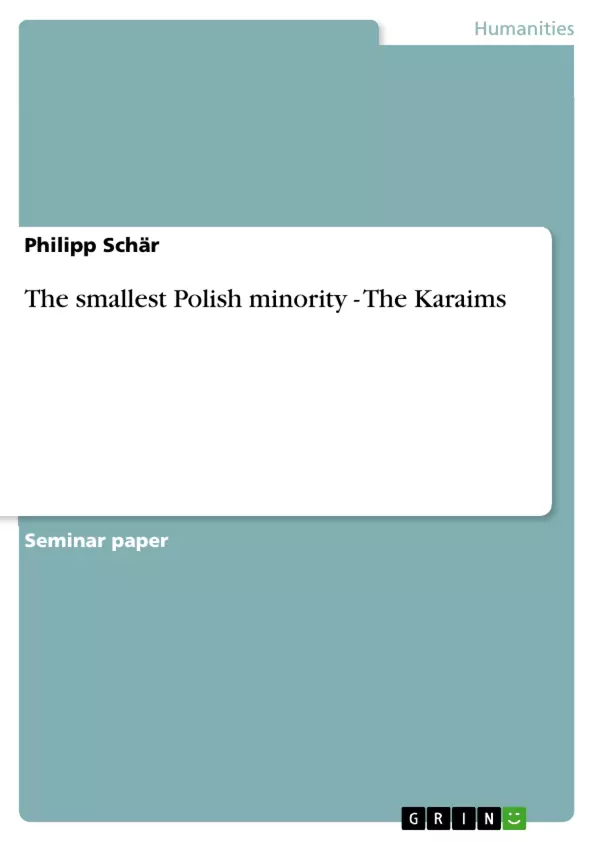If one concerns oneself in Polish and Eastern European minorities and if one looks at the numbers of different minority groups, one group at the end of the list catches ones eye: The Karaim, or Karaites. This minority group exists, depending on the source, of only 40-50 people. The name differs, in some sources they are called Karaim, in others Karaites. In the following chapters I will call them Karaim, as I found out during my research, that they call themselves Karaim or in Eastern Europe also Qaray. Moreover, Karaim is also closer to its origin, but more about this in one of the following chapters. Polands Karaims had since centuries disliked to be called Karaites, as it meant "black dog”. Very special is the Karaim's religion, Judaism as they are ethnically turks
Poland is a ethnically most homogenious state, which was not always so in Poland’ s history. Poles are with 99,3 % the Majority. The different Minorities in Poland are, according to the 2002 census: Among ethnic groups Silesians and Germans are the largest minorities, 172.6 thousand of Polish citizens declare Silesian national identity and 147.1 thousand, German. The third and the fourth linguistic minorities are, respectively, Belorussians, 47.6 thousand, and Ukrainians, 27.2 thousand. The Gypsies appear in fifth position with 12.7 thousand. They are followed by the historical minorities which number from 5 to 10 thousand people: Ruthenians/Lemkos- 5.8 thousand, Lithuanians – 5.6 thousand, and Kashbus – 5.1 thousand. Next there are minor communities like Russians – 3.2 thousand, Slovaks (1.7 thousand), Jews (1.1 thousand), Tartars (0.5 thousand), Czechs (0.4 thousand), Armenians (0.3 thousand) and in last place the Karaim with only 50. At this point I must add, that other sources mention other numbers. Some only 40, others 150.
Karaim Judaism is a Jewish denomination characterized by reliance on the Tanakh as the sole scripture, and rejection of the Oral Law (the Mishnah and the Talmud) as halakha (Legally Binding, i.e. required religious practice). The word Karaim comes from the Hebrew word קְרָאִים (Qəraim), meaning "Readers (of Scripture)". This name was chosen by the adherents of Karaim Judaism to distinguish themselves from the adherents of Rabbinic Judaism.
Inhaltsverzeichnis (Table of Contents)
- Introduction
- Ethnics in Poland
- The Karaims
- What are Karaims?
- Karaims in Eastern Europe
- Language of Karaims in Eastern Europe
- Karaims and Religion
- History of the Karaims
- Karaims today
- Appendix
- Table of figures
- Settlement area
- Bibliography
Zielsetzung und Themenschwerpunkte (Objectives and Key Themes)
This work focuses on the Karaim minority group in Poland, examining their history, culture, and language. Due to limited available resources, especially in English, the scope expands to encompass Karaims in Eastern Europe, with a continued emphasis on the Polish community.
- The Karaims as a distinct minority group in Poland
- The Karaim language and its endangered status
- Religious practices and beliefs of the Karaims
- Historical origins and connections of the Karaims in Eastern Europe
- The Karaim community's efforts to preserve their language and cultural heritage
Zusammenfassung der Kapitel (Chapter Summaries)
- Introduction: The chapter introduces the Karaim minority group in Poland, highlighting their small population and the challenges of researching their history. The author explains their choice to focus on Eastern European Karaims while maintaining a focus on the Polish community.
- Ethnics in Poland: This chapter provides an overview of the various minority groups in Poland, emphasizing the dominance of the Polish majority and highlighting the diverse ethnic makeup of the nation. It discusses the size of different minority groups and their historical context.
- The Karaims: This section delves into the identity and religious practices of the Karaims. It defines Karaim Judaism as a branch of Judaism that relies solely on the Tanakh and rejects the Oral Law. The chapter also touches upon the historical and ethnic connections of the Karaims in Eastern Europe, drawing connections to Turkic and Khazar roots.
- Language of the Karaims in Eastern Europe: This chapter focuses on the unique language of the Eastern European Karaims, classified as a Turkic language. The author discusses the challenges facing the language, including dialectal variations and potential extinction. The chapter also highlights efforts to preserve the Karaim language as a cultural heritage, including projects such as the "Spoken Karaim Project".
- Karaims and Religion: This section delves into the religious beliefs of the Karaims, explaining their rejection of the Rabbinic Oral Law and their focus on the Tanakh as the sole scripture. It emphasizes their distinctiveness within Jewish denominations and their unique understanding of the Torah.
Schlüsselwörter (Keywords)
The key topics and concepts explored in this work include the Karaim minority group, their unique religious beliefs and practices, their distinct language and culture, and their historical connections to Eastern Europe, specifically in Poland, Lithuania, and Ukraine. The author investigates the challenges of preserving their language and cultural heritage, highlighting efforts to document and revitalize their language. The text also explores the Karaim community's self-identification and their historical and ethnic connections to Khazar and Turkic cultures.
- Arbeit zitieren
- Philipp Schär (Autor:in), 2006, The smallest Polish minority - The Karaims, München, GRIN Verlag, https://www.grin.com/document/67808



